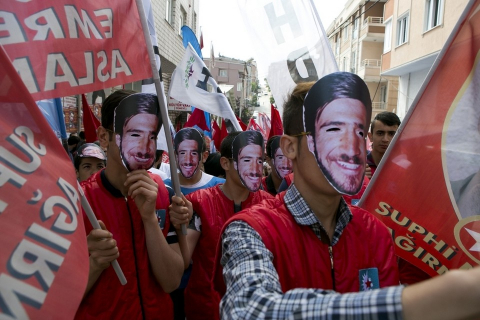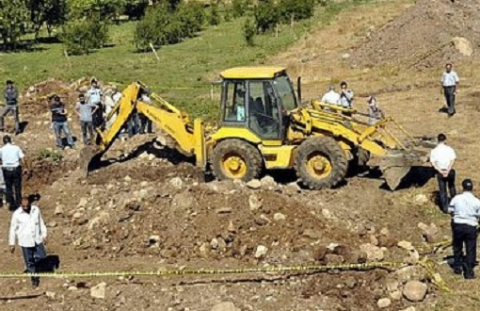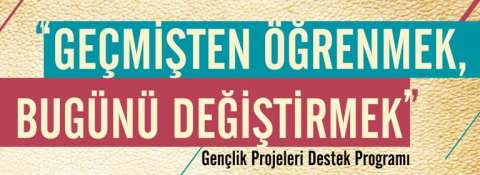
In Diyarbakır, the remains of five people who were detained in 1994 and never heard from again were discovered in a mass grave in 2003. However, their bones went missing. When the bones were later found mixed together in a body bag, the families decided not to open the graves in memory of the dead and on the grounds that excavating the graves wouldn’t be suitable to human dignity. After the bones were determined to be buried in the same bag, the Bulut and Orhan families, who struggled for years to provide their relatives with graves, acquired not a single grave for those relatives, but a mass grave.
Raci Balici, the President of the Diyarbakır Branch of İHD (İnsan Hakları Derneği, or Human Rights Association), said that, according to the Association’s findings, approximately 4000 people were buried in approximately 300 mass graves in the east and southeast. He further stated that they did not want to unearth the graves using current methods of grave excavation. According to Balici, “We don’t want to excavate the graves with construction equipment. Rather, we want to employ a team of experts to open the graves, in line with the Minnesota Protocol. Otherwise, the families who have fought for years to provide their loved ones with their own graves will be forced to suffer the trauma of their remains being mixed up for a second time.”
Relatives Find the Bones, Years Later
The Bolu Mountain Commando Brigade, serving in 1994 as part of the fight against terror, took eight people into custody in Diyarbakır’s Lice District and they were never heard from again. As the result of research by one of the relatives of the disappeared, it was determined in 2003 that there was a mass grave in the area surrounding Bağcılar village in Diyarbakır’s Kulp district, and the information was submitted to the public prosecutor’s office in the district. The prosecutor’s office excavated the grave and found bones, which were sent to the İstanbul Institute of Forensic Medicine, along with blood samples taken from the relatives of the disappeared.
In 2009, following the work done by the Institute of Forensic Medicine, it was revealed that some of the bones removed from the mass grave belonged to Ali Bulut, Emre Bulut, Ramazan Bulut, Hasan Orhan, and Mehmet Orhan, and that the identities of 3 people whose bones were also found could not be determined. The Bulut and Orhan families, who were finally able to collect the bones of their relatives after a span of 15 years, applied to the Kulp Public Prosecutor’s Office, after the bones had been positively identified, with the goal of putting the bones in individual graves.
A 32 kilo bag containing the bones of 8 people was lost
The prosecutor’s office informed the families that the bones of their relatives would not be returned to them and that the location of the bones was unknown. As a consequence, the relatives of the disappeared applied to the Human Rights Association’s (İHD) Diyarbakır Branch. As a result of the initiatives of the directors of the İHD Diyarbakır Branch, the bones of the disappeared were found. It was revealed that the bones of eight people, five of whom had been positively identified, were indiscriminately buried in the same body bag in the Kulp District’s Central Quarter Graveyard. The families of the disappeared, who had been tracking their relatives for fifteen years, decided against excavating the grave because the bones of their relatives were all mixed together in the same bag with the bones of three other unidentified people.
The families did not want to excavate the grave
The Orhan and Bulut families, who applied to the Diyarbakır Special Authority Prosecutor, decided not to open the graves and collect the bones, in memory of the dead and on the grounds that excavating the graves wouldn’t be suitable to human dignity. After this decision, the families, who had been on the trail of their relatives for 15 years and wanted to at least give them a proper grave, discovered not one grave, but a mass grave containing a body bag with the bones of 8 people. A memorial may be erected upon the grave with the names of the five people who were identified.
Bones belonging to 11 PKK members in one body bag
Raci Bilici, President of the Diyarbakır Branch of İHD, wants to draw attention to the truths about mass graves in the region. He said that the mass graves containing the remains of civilians and PKK members buried in the 1990s were opened with construction equipment, as a result of which it became difficult to determine the identities of the remains and the families couldn’t even collect the bones of their relatives because the bones were mixed together. Bilici also said that a mass grave containing the remains of 11 PKK members killed in a conflict in 1995 was found two years ago in the Gercüş District of Batman. Although eight of the eleven were positively identified, the bones were so mixed up that it was not possible to give the families the right bones for individual graves. According to Bilici, “The bones of eleven people, found in a single body bag. They were reburied side by side in graves, with each grave containing a skull and other bones. This situation devastated the families for a second time.”
“Four thousand people buried in 300 mass graves”
Rali Bilici, President of the Diyarbakır Branch of İHD, said that through the association’s work, they have released a map of mass graves in Turkey and have determined that 4000 people are buried in approximately 300 mass graves, both in anonymous graveyards in various provinces and districts in the east and southeast, as well as across the terrain. As a result of significant efforts, according to Bilici, the prosecutors opened the graves, but the excavations have not been mindful of international laws or rules, and witnesses saw construction equipment being used in the excavations. Bilici had this to say:
“In addition to creating serious problems, opening the graves with these unsuitable methods has also made it possible for the evidence in these graves to go missing. It’s a well-known fact that Turkey is still not operating in accordance with the Minnesota Autopsy Protocol and other international protocols. Additionally, given that Turkey has not signed the UN’s “International Convention for the Protection of All Persons from Enforced Disappearance,” it is clear that Turkey has no real interest in working on these issues. While many mass graves in our region have been moved as a result of natural events, some graves face the threat of being submerged by dams. They throw trash on the mass graves, they build roads over them, they put up buildings on them.” (Ferit Arslan – Hürriyet)



